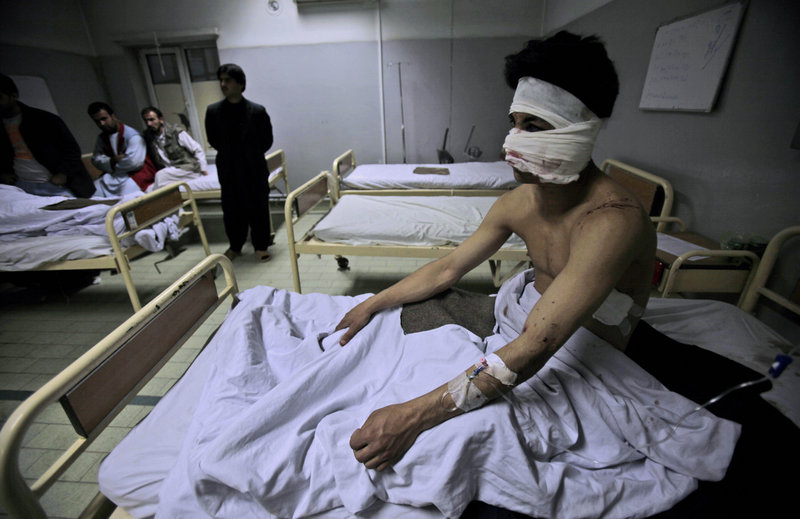KABUL, Afghanistan — A Taliban suicide bomber rammed a vehicle loaded with explosives into an armored NATO bus Saturday on a busy thoroughfare in Kabul, killing 17 people, including a dozen Americans, in the deadliest strike against the U.S.-led coalition in the Afghan capital since the war began.
The blast occurred the same day that a man wearing an Afghan army uniform killed three coalition troops, who were reportedly Australian, in the south – attacks that show the resiliency of the insurgency and are likely to raise new doubts about the unpopular 10-year-old war and the Western strategy of trying to talk peace with the Taliban.
A spokesman for the fundamentalist Islamic movement, which was ousted in the 2001 invasion for its affiliation with al-Qaida, claimed responsibility for the attack, saying the bomber had used 1,540 pounds of explosives.
The Taliban and related groups have staged more than a dozen major attacks in Kabul this year, including seven since June, in an apparent campaign to weaken confidence in the Afghan government as it prepares to take over its own security ahead of a 2014 deadline for the U.S. and other NATO countries to withdraw their troops or move them into support roles.
SETBACK FOR PEACE EFFORTS
Underscoring the difficulties ahead, the brazen assault occurred just hours after top Afghan and Western officials met in the heart of Kabul to discuss the second phase of shifting security responsibilities to Afghan forces in all or part of 17 of the country’s 34 provinces. Afghans already have the lead in the Afghan capital.
Heavy black smoke poured from the burning wreckage of an armored personnel carrier, known as a Rhino, in Kabul after the bomber struck. The bus had been sandwiched in the middle of a convoy of mine-resistant military vehicles when it was hit along a four-lane highway in southwestern Kabul.
The Darulaman Palace, the bombed-out seat of former Afghan kings, was the backdrop to the scene: Shrapnel, twisted pieces of metal and charred human remains littered the street.
U.S. soldiers wept as they pulled bodies from the debris, said Noor Ahmad, a witness at the scene.
One coalition soldier was choking inside the burned bus, he said.
“The bottom half of his body was burned,” Ahmad said.
NATO said five of its service members and eight civilian contractors working for the coalition died in the attack.
A U.S. defense official, speaking on condition of anonymity to release the information before a formal announcement, said all 13 were Americans. However, Lt. Col. Christian Lemay, a Canadian defense spokesman, told The Associated Press that a Canadian soldier was among the troops killed. The discrepancy couldn’t immediately be reconciled.
It was the deadliest single attack against the U.S.-led coalition across the country since the Taliban shot down a NATO helicopter Aug. 6 in an eastern Afghan province, killing 30 U.S. troops, most elite Navy SEALs, and eight Afghans.
GUNMAN KILLS 3 AUSTRALIANS
The Afghan Ministry of Interior said four Afghans, including two children, also died in Saturday’s attack.
In all, there were three attacks Saturday against NATO and Afghan forces across the country.
A teenage girl also blew herself up as she tried to attack an Afghan intelligence office in the capital of Kunar province, a hotbed of militancy in northeast Afghanistan, the coalition said.
Abdul Sabor Allayar, deputy provincial police chief, said the guards outside the government’s intelligence office in Asad Abad became suspicious and started shooting, at which point the bomber set off her explosives, killing herself and wounding several intelligence employees.
Afghan Defense Ministry spokesman Mohammad Zahir Azimi said officials were investigating whether the man who opened fire on a joint NATO-Afghan base in the restive southern Uruzgan province was an actual soldier or a militant in disguise. NATO did not give the nationality of the three service members killed, but the Australian Broadcasting Corp. reported that they were Australian.
“It’s a huge loss,” said U.S. Ambassador Ryan Crocker. “Our deepest sympathies go out to their comrades and families, but it will not deter us from our mission. It’s a shock, but we will not let these guys win.”
ATTACK FOLLOWS OPTIMISTIC REPORT
Just a day earlier, the Pentagon issued a progress report saying that the number of enemy-initiated attacks in Afghanistan was trending downward. Since May , the monthly number of these attacks has been lower than the same month in 2010, something not seen since 2007, it said.
However, the Pentagon also noted that the insurgency’s safe havens in Pakistan and the limited capacity of the Afghan government could jeopardize efforts to turn security gains on the battlefield into long-term stability in Afghanistan.
Saturday’s attack broke a relative lull in the Afghan capital, which has experienced a number of attacks in recent years that are often blamed on the Haqqani network, an al-Qaida and Taliban-linked movement that operates out of Pakistan.
Copy the Story LinkSend questions/comments to the editors.



Success. Please wait for the page to reload. If the page does not reload within 5 seconds, please refresh the page.
Enter your email and password to access comments.
Hi, to comment on stories you must . This profile is in addition to your subscription and website login.
Already have a commenting profile? .
Invalid username/password.
Please check your email to confirm and complete your registration.
Only subscribers are eligible to post comments. Please subscribe or login first for digital access. Here’s why.
Use the form below to reset your password. When you've submitted your account email, we will send an email with a reset code.